
- We will send in 10–14 business days.
- Author: Executive Office of the President
- Publisher: CreateSpace Independent Publishing Platform
- Year: 2014
- Pages: 156
- ISBN-10: 1500207527
- ISBN-13: 9781500207526
- Format: 21.6 x 28 x 0.8 cm, softcover
- Language: English
- SAVE -10% with code: EXTRA
What America's Users Spend on Illegal Drugs (e-book) (used book) | bookbook.eu
Reviews
Description
The Office of National Drug Control Policy sponsored research to update previously published estimates of illegal drug availability on the streets of the United States based on both demand and supply data indicators. The demand-based methodology, published as What America's Users Spend on Illegal Drugs (WAUSID), estimates the magnitude of drugs in the United States by calculating consumption based on surveys of drug use prevalence and frequency. The supply-based methodology, published as Drug Availability Estimates in the United States (DAEUS), estimates the magnitude of drugs in the United States based on supply indicators such as production estimates and seizures. This foreword integrates results of these updates.Trends in the demand and supply-based availability should correlate to trends in the drug consequences (e.g., drug poisonings, drug treatment) in the United States. Figure FW.1 shows the number of reported primary drug treatment admissions for cocaine, heroin, marijuana, and stimulants (which includes methamphetamine) from 1998 through 2006. Cocaine admissions reached a low in 2001, then rose slightly to 263,000 in 2006. Heroin admissions peaked in 2002, then fell slightly in 2006. Marijuana admissions rose steadily from 1998 to 2002, then plateaued through 2006. Treatment admissions for stimulants rose from 1998, until peaking in 2005, then dropped slightly in 2006. Where differences occur between trends in the availability estimates and consequences, potential explanations will be discussed. Based on this evidence, expectations are that methamphetamine availability and use increased over most of 2001 through 2006. For the other drugs, availability and use were relatively constant, although cocaine use may have increased and heroin use may have decreased. Expected changes are not large.
EXTRA 10 % discount with code: EXTRA
The promotion ends in 19d.23:22:59
The discount code is valid when purchasing from 10 €. Discounts do not stack.
- Author: Executive Office of the President
- Publisher: CreateSpace Independent Publishing Platform
- Year: 2014
- Pages: 156
- ISBN-10: 1500207527
- ISBN-13: 9781500207526
- Format: 21.6 x 28 x 0.8 cm, softcover
- Language: English English
The Office of National Drug Control Policy sponsored research to update previously published estimates of illegal drug availability on the streets of the United States based on both demand and supply data indicators. The demand-based methodology, published as What America's Users Spend on Illegal Drugs (WAUSID), estimates the magnitude of drugs in the United States by calculating consumption based on surveys of drug use prevalence and frequency. The supply-based methodology, published as Drug Availability Estimates in the United States (DAEUS), estimates the magnitude of drugs in the United States based on supply indicators such as production estimates and seizures. This foreword integrates results of these updates.Trends in the demand and supply-based availability should correlate to trends in the drug consequences (e.g., drug poisonings, drug treatment) in the United States. Figure FW.1 shows the number of reported primary drug treatment admissions for cocaine, heroin, marijuana, and stimulants (which includes methamphetamine) from 1998 through 2006. Cocaine admissions reached a low in 2001, then rose slightly to 263,000 in 2006. Heroin admissions peaked in 2002, then fell slightly in 2006. Marijuana admissions rose steadily from 1998 to 2002, then plateaued through 2006. Treatment admissions for stimulants rose from 1998, until peaking in 2005, then dropped slightly in 2006. Where differences occur between trends in the availability estimates and consequences, potential explanations will be discussed. Based on this evidence, expectations are that methamphetamine availability and use increased over most of 2001 through 2006. For the other drugs, availability and use were relatively constant, although cocaine use may have increased and heroin use may have decreased. Expected changes are not large.


Reviews